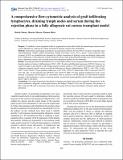| dc.contributor.author | Maenz, Martin | en |
| dc.contributor.author | Morcos, Mourice | en |
| dc.contributor.author | Ritter, Thomas | en |
| dc.date.accessioned | 2011-05-20T15:35:48Z | en |
| dc.date.available | 2011-05-20T15:35:48Z | en |
| dc.date.issued | 2011 | en |
| dc.identifier.citation | Maenz, M., Morcos,M., & Ritter, T. (2011) A comprehensive flow-cytometric analysis of graft infiltrating lymphocytes, draining lymph nodes and serum during the rejection phase in a fully allogeneic rat cornea transplant model. Mol Vis. 2011; 17: 420¿429.PMCID: PMC3038210. | en |
| dc.identifier.uri | http://hdl.handle.net/10379/1917 | en |
| dc.description.abstract | Purpose: To establish a cornea transplant model in a pigmented rat strain and to define the immunologic reaction toward corneal allografts, by studying the cellular and humoral immune response after keratoplasty.
Methods:Full thickness penetrating keratoplasty was performed on Brown Norway (RT1n) recipients using fully major histocompatibility complex (MHC)-mismatched Piebald-Viral-Glaxo (PVG; RT1c) donors. Using multicolor flow cytometry (FACS) we quantified and compared the cellular composition of draining versus non-draining lymph nodes (LN). Furthermore, we developed an isolation method to release viable graft infiltrating lymphocytes (GIL) and subjected them to phenotypic analysis and screened serum from transplanted animals for allo-antibodies.
Results:Assessing ipsi-lateral submandibular LN we find ample evidence for post surgical inflammation such as elevated absolute numbers of cluster of differentiation (CD)4+, CD8+, B-cells, and differential expression of CD134. However, we could not unequivocally identify an allo-antigen-specific immune response. FACS analysis of lymphocytes isolated from collagenase digested rejected corneas revealed the following six distinct subpopulations: MHC-2+ cells, CD4+ T-cells, CD8+ T-cells, CD161dull large granular lymphocytes, CD3+ CD8+ CD161dull natural killer (NK)-T-cells and CD161high CD3- NK cells. At post-operation day (POD)-07 only CD161dull MHC-2neg large granular lymphocytes (LGLs) were detected in syngeneic and allo-grafts. In concordance with an increase in B-cell numbers we often detected copious amounts of allo-antibodies in serum of rejecting animals, in particular immunoglobulin (Ig) M (IgM), immunoglobulin (Ig) G1 (IgG1), and IgG2a.
Conclusions:Our results demonstrate that despite its immune privileged status and low-responder characteristics of the strain combination, allogeneic corneal grafts mount a full fledged T helper1 (Th1) and Th2 response. The presence of NK-T-cells and NK-cells in rejecting corneas shows the synergy between innate and adaptive immunity during allograft destruction. | en |
| dc.format | application/pdf | en |
| dc.language.iso | en | en |
| dc.publisher | PubMed Central | en |
| dc.rights | Attribution-NonCommercial-NoDerivs 3.0 Ireland | |
| dc.rights.uri | https://creativecommons.org/licenses/by-nc-nd/3.0/ie/ | |
| dc.subject | Regenerative medicine | en |
| dc.subject | Regenerative Medicine Institute | en |
| dc.title | A comprehensive flow-cytometric analysis of graft infiltrating lymphocytes, draining lymph nodes and serum during the rejection phase in a fully allogeneic rat cornea transplant model | en |
| dc.type | Article | en |
| dc.description.peer-reviewed | peer-reviewed | en |
| dc.contributor.funder | IRCSET | en |
| dc.contributor.funder | SFI | en |
| nui.item.downloads | 337 | |


